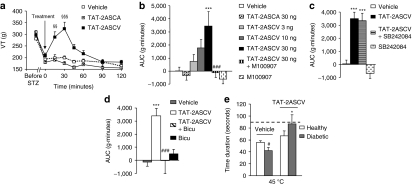Figure 2.
Disruption of 5-HT2A receptor/PDZ protein interactions produces antihyperalgesic effects in diabetic neuropathic rats. (a) Diabetic hyperalgesic rats were injected with either the TAT-2ASCV or the TAT-2ASCA peptide (30 ng/rat i.t., each) or vehicle (10 µl/rat i.t.). The vocalization thresholds to paw-pressure were measured up to 120 minutes after the injection. §§P < 0.01 and §§§P < 0.001, compared with values measured before the peptide/vehicle injection (time 0). (b) Diabetic rats were injected with the indicated doses of the TAT-2ASCV peptide or with the TAT-2ASCA peptide (30 ng/rat i.t.) or with M100907 (150 ng/rat i.t.) in the absence or presence of the TAT-2ASCV peptide (30 ng/rat, i.t.). Data, expressed as area under the time-course (0–60 minutes) curve (AUC) of vocalization threshold variations, are means ± SEM of values obtained in 6–12 rats. ***P < 0.01, versus vehicle. ###P < 0.001 versus TAT-2ASCV (30 ng/rat)-treated group. (c) Diabetic rats were injected with SB242084 (150 ng/rat i.t.) in the absence or presence of the TAT-2ASCV peptide (30 ng/rat, i.t.). Data, expressed as in b, are means ± SEM of values obtained in six rats. ***P < 0.01, versus vehicle. (d) Inhibition of the antihyperalgesic effect of the TAT-2ASCV peptide (30 ng/rat i.t.) by bicuculline (Bicu, 3 µg/rat i.t.) in diabetic rats (n = 10–17). ***P < 0.001 versus vehicle. ###P < 0.001 versus TAT-2ASCV-treated group; data are expressed as b. (e) Thirty minutes after injection, the TAT-2ASCV peptide (30 ng/rat i.t.) suppressed thermal hyperalgesia in diabetic rats, as shown by the increase in time duration spent on the plate set at 45 °C (n = 4–7 rats), see legend of Figure 1e. *P < 0.05, compared with values measured before the peptide/vehicle injection (time 0). i.t., intrathecal; VT, vocalization thresholds.

